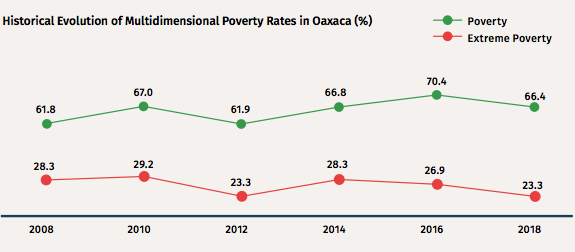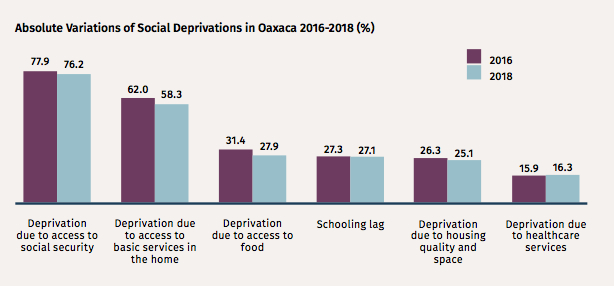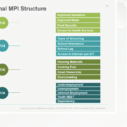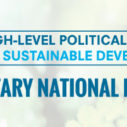
Search
The Use of the Multidimensional Poverty Measure in Oaxaca
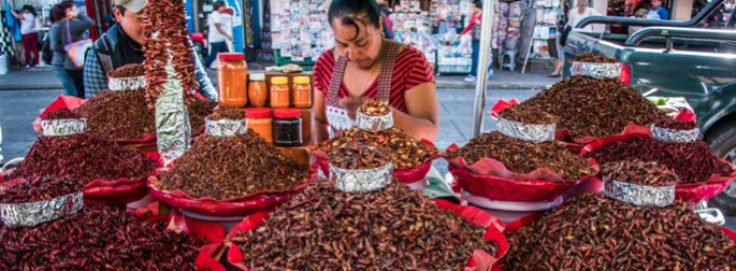
Oaxaca is a Mexican state that is rich in both natural resources and cultural heritage. It is the cradle of the Zapotec and Mixtec cultures, which are emblematic of the Pre-Hispanic period. At 93,757 km2, it is the fifth largest state in Mexico and has 3.8 million inhabitants, with an average age of 24 years – two years younger than the national average. It is a young population that represents a great advantage for the state’s social and economic development. Sixty per cent of the population is indigenous, and 33% speak an indigenous language.
Paradoxically, it is a state that continues to have high levels of poverty. The results of the latest measurement of multidimensional poverty carried out by CONEVAL show that, in 2016, 70.4% of the total population, or 7 out of every 10 people, found them- selves in a situation of poverty. This is the highest percentage since measurements were established. Nonetheless, in 2018 there was a significant reduction in poverty of 4 percentage points (or the equivalent of 132,644 people who overcame poverty) and a reduction of 3.6 percentage points in extreme poverty (135,308 people who overcame extreme poverty), making Oaxaca the state with the greatest reduction in poverty nationwide over the past two years.
Source: Results of poverty in Mexico 2018 at a national level and by states, CONEVAL.
There was also a reduction in five of the six social deprivations and in the income-based deprivation measured by the poverty index. The reduction in the indicator of social security was the highest in the country with a reduction of 1.7 percentage points (35,041 people) – in contrast with the national trend that showed an increase of 1.5 points. The lack of basic housing services was reduced by 3.7 percentage points (122,543 people) while it increased by 0.5 points at the national level. Moreover, the reduction in deprivations due to access to food was 3.5 percentage points (126,637 people), which represents the third highest reduction in the nation and contrasts with a national increase of 0.2 percentage points. It is noteworthy too that current average household income is at its highest point in the last ten years, and the population with enough income to buy food and have access to a decent life has increased by 3.7 percentage points (118,996 people).
Source: Results of poverty in Mexico 2018 at a national level and by states, CONEVAL.
How was this advance achieved? The Oaxaca Ministry of Social and Human Development (SEDESOH in Spanish) is in charge of designing strategy to fight poverty in Oaxaca. Its success is based on two components: (1) political support at the highest level and (2) planning and targeting public investment and public policies through diagnostics with both a quantitative and qualitative focus on poverty at the state and municipal level.
Political will at the highest level
The governor of Oaxaca, Alejandro Murat Hinojosa, established a Technical Committee to fight poverty, with the participation of cabinet members in charge of targeting the six social deprivations. That led to involvement at the highest levels of government in decisions -that ranged from how to apply public policies to how to monitor established goals in order to evaluate their progress. In addition, it facilitated participation and commitment on the part of academia, the production sector, and civil society.
Planning and focus
a) Quantitative diagnosis
The results of the multidimensional measurements of poverty have been extremely useful for the precise diagnosis of social deprivations and their impact on poverty. They helped us to have a high-definition lens of the degree of poverty in municipalities and of the most pressing sub-deprivations. Using this information, we defined the strategy to fight poverty in 40 top-priority municipalities, with an ongoing
The results of the multidimensional measurements of poverty have been extremely useful for the precise diagnosis of social deprivations and their impact on poverty.
focus on the areas with the greatest concentration of people, in terms of concrete numbers and percentages, who are in situations of poverty and extreme poverty –what we call the ‘E-40’. Using CONEVAL’s data we were able to identify the number of homes that do not have basic services such as drinking water, electricity, drainage, a solid roof or floor, and the number of people who do not have access to health- care services, social security, or education.
b) Qualitative diagnosis
Using quantitative data, we have identified that the greatest social sub-deprivation in Santos Reyes Yucuná – the municipality with the highest percentage of people living in poverty (99.9%) – is drainage, followed by access to food, drinking water, and stoves without chimneys. Nonetheless, identifying social problems required looking beyond the numbers. To do this, SEDESOH collaborated with the Centre for Research and Advanced Studies in Social Anthropology (CIESAS) South Pacific Unit to conduct a qualitative study of the municipality.
The main results revealed that poverty in this municipality was mainly due to a shortage of water, which is exacerbated during dry periods. This lack of water has direct and dire repercussions for the community: it makes productive agriculture and livestock farming impossible and compels people to migrate to large urban centres outside of the state, where they often attempt to support themselves as street seller people. It also directly affects children who quit school to work with their parents (an effect of migration).
Parents also leave for work reasons, which affects children and is directly reflected in school lag. In the rainy season the population returns to the community to engage in agricultural work (fallowing, ploughing, planting, and clearing the corn harvest). This dynamic is responsible for on-going circular migration, which limits both the ability to generate income and the productive activities of the municipality, and, in turn, limits the community’s development.
This is the reason why, once the results were obtained, the complementary information provided by the quantitative and qualitative data became evident. While the statistical data suggests a concentration in the six social deprivations, the qualitative study outlines some other aspects that are not considered in the metrics, such as the phenomenon of migration or the community’s productivity. Following this, planning for interventions and spending targeting can focus on both analyses. For example, we found the five greatest social sub-deprivations in the state were the lack of stoves with chimneys, workers without access to healthcare, the lack of drainage, a lack of food, and adults who have not finished primary school.
Interactive maps were also created to illustrate the degree and intensity of the social sub-deprivations in each municipality, even indicating by street the areas with the highest concentration of the population suffering the given sub-deprivation. For example, we know that in the municipality of San Juan Bautista Tuxtepec the lack of access to healthy, varied, and sufficient food is the main cause of poverty. Thanks to the use of this map, areas of the municipality that required public policy interventions to combat the problem were identified. The use of this tool by agencies and entities that execute the programs and social actions promotes an effective use of public resources by focus- ing attention on the areas with the highest concentration of people who are experiencing some kind of deprivation and directing support to those who really need it.
 In conclusion, in Oaxaca we have a solid strategy to fight poverty and in implementing it we have been able to reverse the trend of poverty growth over the past eight years. Aided by the complementarity of the quantitative tools and the qualitative studies, we have defined on-going and priority actions on a municipal level, fulfilling institutional commitments that ensure the population’s social rights.
In conclusion, in Oaxaca we have a solid strategy to fight poverty and in implementing it we have been able to reverse the trend of poverty growth over the past eight years. Aided by the complementarity of the quantitative tools and the qualitative studies, we have defined on-going and priority actions on a municipal level, fulfilling institutional commitments that ensure the population’s social rights.
Finally, we face great challenges in the implementation, monitoring, and evaluation of that strategy due to the geographic complexity of the Oaxacan territory, which is largely mountainous; the highly dispersed population (with more than half living in towns of fewer than 2,500 inhabitants); and the in- equality of our women and indigenous people, who are our greatest source of wealth. Our vision for development is a combination of financial well-being with the full exercise of social rights within a sustainable framework.
Original in Spanish. Translated by Kristin Fisher.
This article was published in Dimensions 8.















